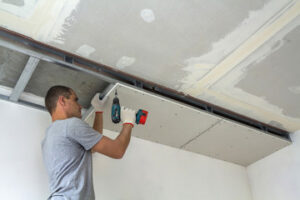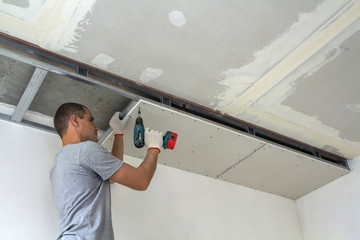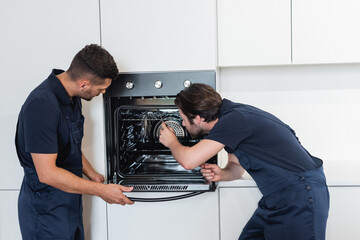Drywall is pretty tough stuff, but it’s not indestructible. It can get dented by kids flinging their toys or heavy furniture falling against the wall.
Fortunately, these dents are easy to fix. You’ll need some drywall compound or spackle and paper tape. A little interior painting is over the top, and your drywall repair is almost invisible. For professional assistance, visit https://www.drywallcompanylasvegas.com/.
A hole in your wall isn’t just unsightly, it can also be a point of entry for critters that you don’t want in your home. In addition, it can cause a draft and increase your electric bill. Whether it’s from an accident or an ongoing problem, you need to learn how to patch drywall holes quickly and efficiently to keep your walls looking great.
For small nail holes and other minor repairs, you can use a quick-drying spackling paste or joint compound to cover them up and make them look seamless. Apply a thin layer with a putty knife and then smooth it over the area, feathering the edges to blend into the solid wall. Allow it to dry overnight and then lightly sand the surface, if necessary.
Larger holes in drywall can be more difficult to fix. You can try using a drywall patch, which is available at most hardware stores. However, according to Dennis McGee, owner of Mr. Handyman in Leesburg, FL, this method is not always successful and requires a lot of prep work. First, you need to cut out the damaged section of the wall, removing all the way to the center of each stud on either side of the hole. This isn’t easy, but it’s essential to getting a good-looking patch.
Another option is to build up the surrounding wall and then place a new piece of drywall. To do this, you need to square off the hole and then clear any chipped paint or drywall debris. For a more professional finish, you can also brace the area by cutting a piece of furring strip that’s about 4 inches longer than the width of the hole and then screwing it into place on both sides.
Once the furring strip is in place, you can attach a new piece of drywall to it using a drywall screw gun. Before you do, though, you’ll need to trace the shape of the hole onto the back of the drywall and then cut it out with a utility knife. If the hole is too big, you may need to repeat this step or use a larger piece of drywall.
Repainting
If you aren’t planning to do any more major drywall repair, simply painting over the damaged area can hide it completely. You can buy a quart of color-matched paint at most home centers for around $10 to $55, and you probably have some leftover from when you painted the rest of the room. If you use a touch-up brush and feather the edges of the patch, it will blend into the wall.
For small indentations, scuff marks and scrapes, you can use spackle and a smoothing tool to make the surface look as good as new. For larger holes, it’s more convenient to purchase aluminum patches (at home centers) that are much easier to install than traditional drywall pieces. Cut the patch so that it covers the hole by at least 1 in. on each side, then apply a layer of drywall joint compound to the wall. Smooth and sand the area until it is level with the rest of the wall, then apply a second coat and sand again.
Before you repaint, remove any dust from the repaired areas with a damp rag or vacuum. If you don’t, the dust will settle and show up as tiny dots on your finished wall. If you’re painting over oil-based paint, don’t forget to prime the repaired area for better adhesion and color blending.
You can also use a drywall repair kit for simple cracks, dents and other imperfections. Typical kits include a can of drywall mud, a putty knife and sandpaper, all for under $100.
If you have a lot of holes or cracks, hiring a professional can be a wise investment. A drywall contractor can repair larger holes or entire sheets of drywall, and can apply texture, primer and wall paint.
For vertical drywall cracks that appear above or below doors and windows, you can fix them using self-adhering mesh tape and a sanding sponge. Smooth the surface, then apply two or three thin coats of drywall mud, sanding between each application and applying a light sanding before each coat. Use a light hand and don’t go overboard, or the cracks will show.
Repairing a Holes in the Wall
No matter how careful you are, if you live in a house long enough it’s inevitable that little nail holes will pop up and need to be repaired before applying paint. Fortunately, fixing a hole in the wall is a relatively simple home improvement project that most homeowners can manage. Unless the damage is extensive, all you need are a few tools and a drywall patch kit.
Start by removing any loose or broken bits of drywall. Then use a putty knife to fill the hole with spackling or wall joint compound. Aim to create a surface that’s smooth and even with the rest of the wall or ceiling. When the first coat is dry, apply a second coat to tape the edges of the hole. You can use a four-inch putty knife to do this, but a specialty inside-corner tool makes the job much easier.
If the damage is more severe, brace the area with a piece of wood like plywood or 1×3. Screw it into place through the center of the hole and onto adjacent studs on both sides. This will keep the new drywall patch from pulling away from the wall as it dries.
For smaller holes, you can also cover the opening with a self-adhering mesh patch. These kits are convenient, but they’ll leave a noticeable seam in the wall. You can hide the seam with drywall tape instead, or if you can see the studs through the hole, you can cut a piece of drywall that’s about the same size as the damaged section and attach it to the studs by nailing or screwing it.
If you’re repairing a larger hole, it helps to sketch out the outline on the back of your drywall patch before you begin cutting. This will help you determine how big of a patch you need and where to cut the panel. If possible, avoid enlarging the hole as this may interfere with electrical cords and plumbing lines that run through the studs behind the wall. If you need to enlarge the hole, first shine a flashlight into the gap to make sure you’re not cutting into any wires or other components.
Repairing a Crack in the Wall
Small cracks and holes in a wall can be easy to fix on your own, but larger ones may require the services of a pro. Many drywall contractors have a minimum rate for a job and it’s more cost-effective to pay the extra money to hire a professional for large jobs that involve patching or repairing cracks, dents or tears, rather than handling multiple smaller tasks yourself.
Whether you’re dealing with a hole or a crack, the first step is to determine what’s making the mark and how deep it is. If it’s a shallow crack, you may be able to cover it with a self-adhering fiberglass patch or, if the studs are visible, a piece of drywall cut to fit the area.
If the crack is wide, you’ll need to repair the entire edge of the damaged drywall. To do this, spread a thin coat of joint compound (also known as drywall mud) over the whole area using a 3- to 4-inch putty knife made for drywall, not wood putty. Smooth the compound with long, continuous strokes until it’s level with the rest of the wall. Add a second and third coat as needed to get the area completely level. After the last coat, sand the surface lightly, but don’t expose the paper tape — you’ll need it to hold your repair.
In older homes, cracks in walls are often the result of normal house settling. But cracks can also appear around windows and doors, as well as in the corners of rooms. They’re sometimes caused by water leaking into the wall’s framing, usually from a leaky window or roof or from a pipe in an attic.
Most cracks in a wall can be repaired by taping and sanding the drywall joints, where the edges of two pieces meet. Occasionally, however, the crack can signal a larger problem and may indicate the need for structural repairs or other remedial steps. For example, if a crack extends vertically up from the base of the wall, it may be flagging an issue with the foundation.


 Individuals looking for an appliance repair service provider are often interested in hiring a highly skilled appliance repair specialist to perform all necessary repair, setup, and maintenance tasks needed by customers. The appliance repair specialist’s duties include the following:
Individuals looking for an appliance repair service provider are often interested in hiring a highly skilled appliance repair specialist to perform all necessary repair, setup, and maintenance tasks needed by customers. The appliance repair specialist’s duties include the following: